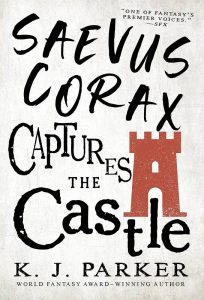Gary K. Wolfe Reviews Saevus Corax Deals with the Dead by K.J. Parker
 Saevus Corax Deals with the Dead, K.J. Parker (Orbit 978-0316668903, $18.99, 359pp, tp) October 2023.
Saevus Corax Deals with the Dead, K.J. Parker (Orbit 978-0316668903, $18.99, 359pp, tp) October 2023.
Saevus Corax Captures the Castle, K.J. Parker (Orbit 978-0316668910, $18.99, 352pp, tp) November 2023.
Readers of K.J. Parker are by now familiar with his affable scoundrels – by turns digressive, philosophical, deeply cynical, petulant, and somehow both self-loathing and self-justifying in the same breath. Saevus Corax, the playwright-turned-battlefield-scavenger who is the protagonist of Parker’s new Corax Trilogy, may be the quintessential Parker narrator, unreliable and proud of it, even as his voice begins to sound a bit familiar from earlier work. “Not my fault,” he whines after an entire kingdom collapses on his watch in Saevus Corax Deals with the Dead. “I didn’t start it.” Actually, he has a point. Throughout these novels (the three are being published very close together, but third volume, Saevus Corax Gets Away with Murder, wasn’t available to me by deadline), Corax is abducted, imprisoned, blackmailed, manipulated, beaten up, rescued, and double-crossed so often that it seems almost generous to call him a protagonist at all. As intriguing as these hapless rogues may be, though, much of the appeal of Parker’s fiction involves the intricate alternate version of medieval Europe that he has developed over several novels and novellas, the detailed descriptions of everything from how to build a catapult to how to make blue paint, the convoluted plot twists, and a cast of vivid secondary characters whose snappy dialogue owes more to Howard Hawks comedies and Wodehousian put-downs than to medieval troubadours. Parker’s fiction may seldom feature any material fantasy at all – no dragons or wizards here – but his world is as vivid and detailed as anyone’s.
Saevus Corax Deals with the Dead presents itself as “a true and accurate history of the Great Sirupat War, told by someone who was there,” which is Parkerese for “don’t believe a word I’m about to say” – especially since it follows an opening paragraph which is a paean to the virtues of lying. We first meet Saevus as a once-successful playwright, now a self-described “battlefield salvage contractor,” meaning he pays for the rights to plunder battlefields – one of his crew specializes in arrows, another in armor, even one who collects human body parts. Returning to the island monastery which sort of serves as his headquarters, he finds nearly all the monks missing and the monastery sacked – but only of weapons and a few undistinguished books, with the actual treasures left behind. Later, Saevus finds himself inexplicably framed for a pirate raid on a revenue ship. As these mysteries unfold, Saevus is drawn into a power struggle between factions called the Knights of Equity and the Poor Sisters, each seeking control of the nation of Sirupat. As the novel rapidly expands its scope and reveals very important details about Saevus’s own family background – which he’s simply not deigned to mention before now – Parker’s characteristically twisty plotting offers a succession of dark and delightful surprises, as well as a rather haphazard but full-scale war.
 Of the secondary characters, the most important is the nominal leader of the Poor Sisters, Stauracia, who also plays a central role in Saevus Corax Captures the Castle. Like Saevus, Stauracia seems to have a variety of identities, and her genius for concocting elaborate schemes matches his own; she’s effectively Irene Adler to Saevus’s Sherlock Holmes. Their mutual attraction and distrust, marked by deliciously snarky dialogue as they become unwilling collaborators, is evident in the first novel but becomes a central thread in the second. After cleaning up another battle scene, Saevus’s crew is attacked and all but a few are abducted – as it turns out, by Saevus’s vindictive mother-in-law Praeclara, who will release them only after Saevus agrees to capture a well-fortified castle, even though his men have no experience in such matters. The castle, meanwhile, is defended by none other than Stauricia, who tells Saevus that she herself is being blackmailed by mysterious figures who have kidnapped her son (or at least someone she calls her son). While a few plot points are carried over from the first novel – such as those mysterious missing books from the monastery – the scope of Saevus Corax Captures the Castle is more intimate, the plot more direct and novella-like, even as the stakes remain high. A long and at times harrowing passage involves Saevus undertaking a hazardous solo expedition to track down his wife and the daughter he has never seen, by making his way through a hostile region called Hetsuan, which seems to have a distressing policy of killing and eating any outsiders who show up. He eventually survives with the aid of some unexpected allies, and sets out to reclaim his career, extending it to tomb-raiding. A few years ago, Parker published The Big Score, a novella about his brilliant con-man philosopher Saloninus, but it might as well be the overall title of the Corax trilogy, since the characters incessantly talk about making the big score that will set them up for life. Will Saevus’s ragtag band finally find theirs? Has Stauricia already made hers, since Saevus now suspects she might be the wealthiest woman in the world? Will more pesky wars and hostile in-laws continue to wreak havoc on everyone’s best and most devious plans? Whatever the third volume promises in terms of convoluted plot developments – and we can certainly expect some – it’s almost certain to be as wildly cynical and hilarious as we’ve come to expect from a writer whose voice is entirely his own, and is unfailingly entertaining.
Of the secondary characters, the most important is the nominal leader of the Poor Sisters, Stauracia, who also plays a central role in Saevus Corax Captures the Castle. Like Saevus, Stauracia seems to have a variety of identities, and her genius for concocting elaborate schemes matches his own; she’s effectively Irene Adler to Saevus’s Sherlock Holmes. Their mutual attraction and distrust, marked by deliciously snarky dialogue as they become unwilling collaborators, is evident in the first novel but becomes a central thread in the second. After cleaning up another battle scene, Saevus’s crew is attacked and all but a few are abducted – as it turns out, by Saevus’s vindictive mother-in-law Praeclara, who will release them only after Saevus agrees to capture a well-fortified castle, even though his men have no experience in such matters. The castle, meanwhile, is defended by none other than Stauricia, who tells Saevus that she herself is being blackmailed by mysterious figures who have kidnapped her son (or at least someone she calls her son). While a few plot points are carried over from the first novel – such as those mysterious missing books from the monastery – the scope of Saevus Corax Captures the Castle is more intimate, the plot more direct and novella-like, even as the stakes remain high. A long and at times harrowing passage involves Saevus undertaking a hazardous solo expedition to track down his wife and the daughter he has never seen, by making his way through a hostile region called Hetsuan, which seems to have a distressing policy of killing and eating any outsiders who show up. He eventually survives with the aid of some unexpected allies, and sets out to reclaim his career, extending it to tomb-raiding. A few years ago, Parker published The Big Score, a novella about his brilliant con-man philosopher Saloninus, but it might as well be the overall title of the Corax trilogy, since the characters incessantly talk about making the big score that will set them up for life. Will Saevus’s ragtag band finally find theirs? Has Stauricia already made hers, since Saevus now suspects she might be the wealthiest woman in the world? Will more pesky wars and hostile in-laws continue to wreak havoc on everyone’s best and most devious plans? Whatever the third volume promises in terms of convoluted plot developments – and we can certainly expect some – it’s almost certain to be as wildly cynical and hilarious as we’ve come to expect from a writer whose voice is entirely his own, and is unfailingly entertaining.
Gary K. Wolfe is Emeritus Professor of Humanities at Roosevelt University and a reviewer for Locus magazine since 1991. His reviews have been collected in Soundings (BSFA Award 2006; Hugo nominee), Bearings (Hugo nominee 2011), and Sightings (2011), and his Evaporating Genres: Essays on Fantastic Literature (Wesleyan) received the Locus Award in 2012. Earlier books include The Known and the Unknown: The Iconography of Science Fiction (Eaton Award, 1981), Harlan Ellison: The Edge of Forever (with Ellen Weil, 2002), and David Lindsay (1982). For the Library of America, he edited American Science Fiction: Nine Classic Novels of the 1950s in 2012, with a similar set for the 1960s forthcoming. He has received the Pilgrim Award from the Science Fiction Research Association, the Distinguished Scholarship Award from the International Association for the Fantastic in the Arts, and a Special World Fantasy Award for criticism. His 24-lecture series How Great Science Fiction Works appeared from The Great Courses in 2016. He has received six Hugo nominations, two for his reviews collections and four for The Coode Street Podcast, which he has co-hosted with Jonathan Strahan for more than 300 episodes. He lives in Chicago.
This review and more like it in the December and January 2023 issue of Locus.
 While you are here, please take a moment to support Locus with a one-time or recurring donation. We rely on reader donations to keep the magazine and site going, and would like to keep the site paywall free, but WE NEED YOUR FINANCIAL SUPPORT to continue quality coverage of the science fiction and fantasy field.
While you are here, please take a moment to support Locus with a one-time or recurring donation. We rely on reader donations to keep the magazine and site going, and would like to keep the site paywall free, but WE NEED YOUR FINANCIAL SUPPORT to continue quality coverage of the science fiction and fantasy field.
©Locus Magazine. Copyrighted material may not be republished without permission of LSFF.






Who narrates the audiobook? Is that the author?